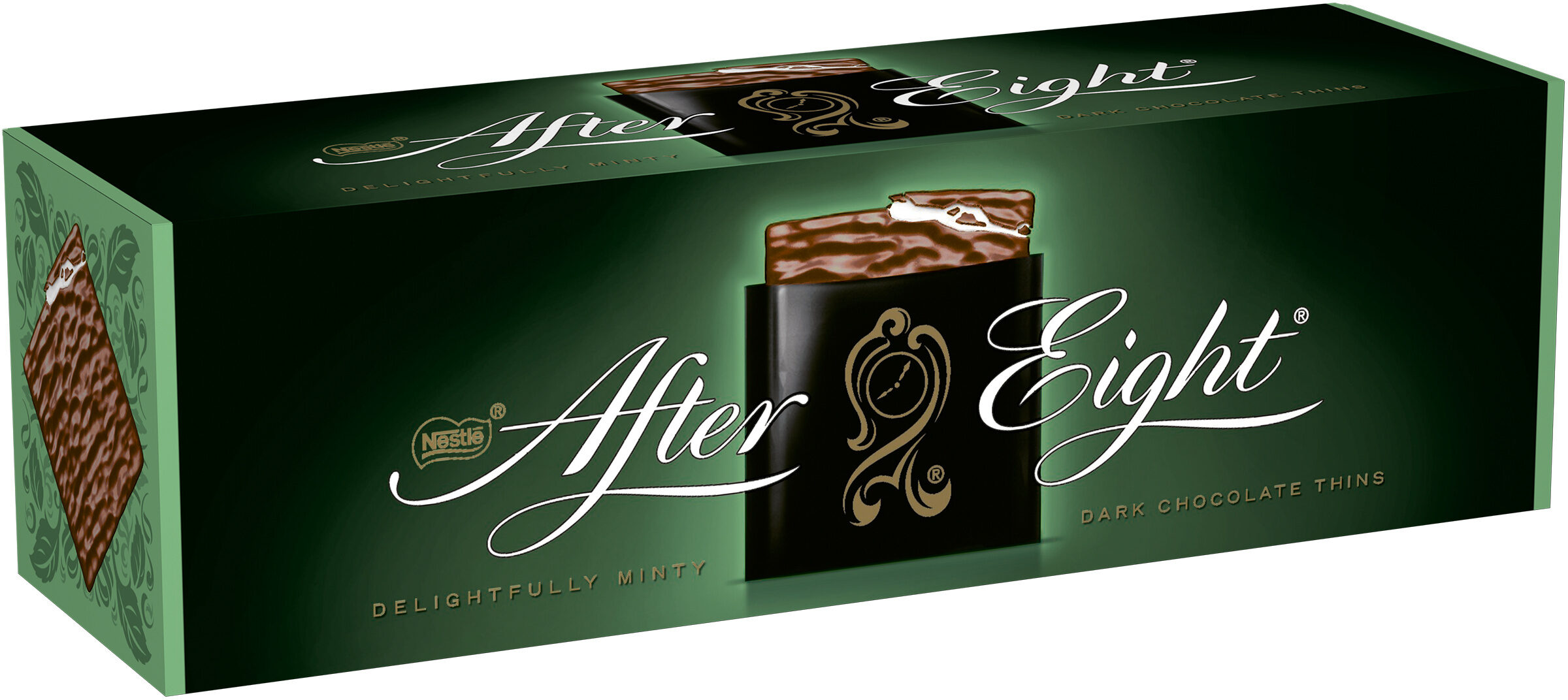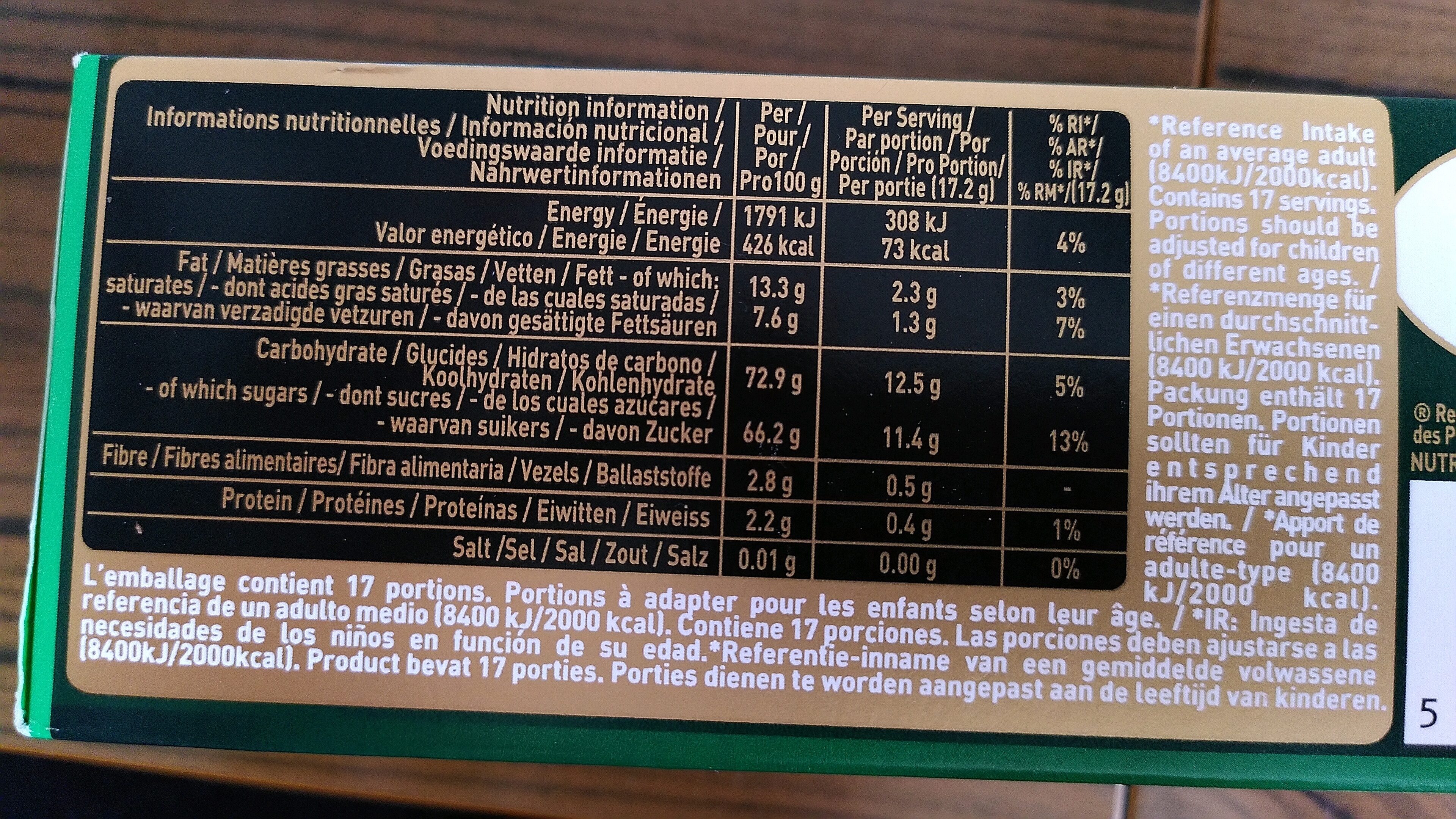AFTER EIGHT Coffret 300g - Nestlé - 300 g
Some of the data for this product has been provided directly by the manufacturer NESTLE FRANCE. - Customer service: Contact form 0 809 400 412 (service gratuit + prix de l'appel)
Côd bar: 5000426171518 (EAN / EAN-13)
Common name: Fines feuilles de chocolat noir fourrées à la menthe (60,4%). Le chocolat noir contient des matières grasses végétales en plus du beurre de cacao
Quantity: 300 g
Packaging: en:Box, en:Cardboard, en:Sleeve, en:card-carton, en:mixed plastic-film, en:paper-tray, en:paper-wrapper
Brandiau: Nestlé
Categorïau: en:Snacks, en:Sweet snacks, en:Cocoa and its products, en:Confectioneries, en:Chocolates, en:Dark chocolates, en:Filled chocolates, en:Dark chocolate filled with mint confectionery
Labels, certifications, awards:
en:Vegetarian, en:Nestlé Cocoa Plan, en:Rainforest Alliance, Rainforest Alliance Cocoa, Triman

Origin of the product and/or its ingredients: ROYAUME-UNI
Origin of ingredients: Y Deyrnas Unedig
Manufacturing or processing places: York, Reino Unido
Traceability code: 040503190002, RNE 00000600, RNPA 0680004
Link to the product page on the official site of the producer: https://www.nestle.co.uk/
Stores: Leclerc, Asda, Magasins U, Delhaize, Intermarché, carrefour.fr, Ketal, Farmacorp, IC Norte
Countries where sold: Gwlad Belg, Ffrainc, Sbaen, Y Deyrnas Unedig
Matching with your preferences
Other information
Preparation: Produits prêt à l'emploi
Conservation conditions: A conserver au sec et à l'abri de la chaleur.
Customer service: Nestlé France, 34-40 rue Guynemer 92130 Issy-les-Moulineaux
Report a problem
Data sources
The manufacturer NESTLE FRANCE uses Equadis to automatically transmit data and photos for its products.
Product added on gan am-i-an-alien
Last edit of product page on gan dwarfclimb.
Golygwyd y tudalen cynnyrch hefyd gan 5m4u9, averment, blious257, chatainsim, countrybot, driveoff, ecoscore-impact-estimator, foodless, foodrepo, fpdsurveys, gluten-scan, inf, isabel626, jiehong, kch, kiliweb, magasins-u, mairoluin, musarana, noii, off.a2ffe86e-8de3-45e2-b6e7-31e1add81c30, openfoodfacts-contributors, orelia, org-nestle-france, packbot, roto, scanbot, swipe-studio, tacinte, tacite, tacite-mass-editor, teolemon, tequiladog, thaialagata, yuka.SDY0a0NKcFFsS0U0dTlvOTNVcmF4WXhULzQ2VFluK25CT1V2SVE9PQ, yuka.UVlaY0Nmb2NvL0Jia3NNNThoRDgxTkI4N1pPTUIzSzJOTEFWSVE9PQ, yuka.YlkxZkY0a05vc0kzbFBZRTd5bjMydGx2bTdxVloxcTVNdklZSVE9PQ, yuka.YmFJdlFZRVB1dGNod2NJZHBoanRxLzFueTZLU2JXRzZNYm9YSWc9PQ, yuka.Zks4R1RLbGVsOVl3dHN4ZzlSVEZwb2h0bmMvMWQxcXFGL1ZBSUE9PQ, yuka.sY2b0xO6T85zoF3NwEKvlklFA8XjnRvZbCHSiUKZ9_jVIYTzX_NU2tPbFKs, yukafix.














